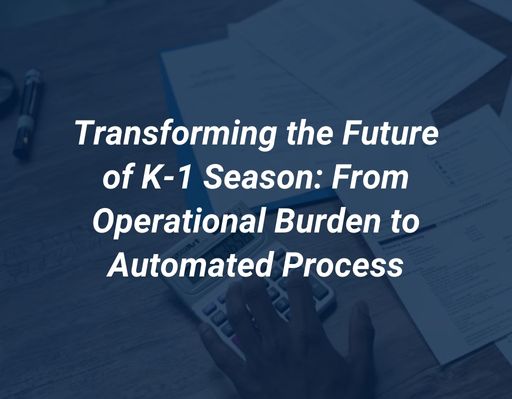Transforming the Future of K-1 Season: From a Constant Operational Burden to an Automated Process

Every spring, K-1s reappear as a major topic of discussion and significant operational burden in preparing for the upcoming tax season. A Schedule K-1 is an IRS tax form that is issued on an annual basis to report on each partner’s share of a partnership’s earnings, losses, deductions, and credits. As with any other federal tax document, ensuring successful document receipt and collecting accurate information are two of the most important tasks for the operations team during this time.
Typical Process for K-1 Tracking
K-1 season, in truth, essentially takes place throughout the entire year. As a constant tracking exercise that firms have to go through each year, the persistence of K-1s tends to become a pain point that is reset just as soon as it is resolved. The time that passes between when the document is first issued and when it is done often ends up surpassing nine months.
A single fund may have dozens of different K-1s across various states depending on what the team has invested in. Whether you need to process a single K-1 or twenty, it’s crucial that your team is able to monitor each unique K-1 and ensure expectations are met for each.
What does this look like?
- Tracking what information you do and don’t have in a master spreadsheet for each fund
- Constantly monitoring for new updates and reactively amending stale or missing data
- Overseeing version control between multiple parties
- Cross-checking and validating updates made by your colleagues
- Persistently following up with various stakeholders regarding missing or late documents
- Sharing the relevant K-1s with accountants or other professional service providers for additional processing
- Managing the information security risk of this extremely sensitive tax information
Already a burdensome process to handle a single K-1, for firms expecting multiple, the operational overhead needed to support K-1 season can grow to be quite significant rather quickly. Fortunately, there’s a better way to handle it – with automated solutions.
K-1 Tracking with Canoe: Automated
When you implement a system like Canoe’s that automates your K-1 processing, the technology performs the work on your behalf. Rather than allocating significant time to the K-1 workflow over the course of the year, with Canoe, you can simply log in to the dashboard to make a quick assessment of the current status of your K-1s in minutes.
Many Canoe clients have already transformed their K-1 processing workflow with our platform. Trevor Hicks, Chief Technology Officer at Wetherby Asset Management, said “Canoe has made it easier for us to retrieve K-1s and related tax documents by client, rather than pulling the documents by fund, which is how we were operating in the past. This is saving us time in the back office.”
What does this look like?
- Completely automated and secure tracking and collection process
- Holistic view of your entire inventory and relevant status updates accessible in near real-time
- Proactive notifications detailing newly received tax forms and highlighting missing or late documents based on your expected timeframes
- Streamlined document delivery to your downstream systems and third parties, such as accountants, through an easily accessible portal and API connections
- Hours upon hours of your operations team’s time reallocated to higher-value activities
Some of the world’s largest asset servicers trust Canoe to do this work reliably and securely on their behalf. Interested in learning more about how Canoe can transform your annual K-1 process? Request a demo to get started.